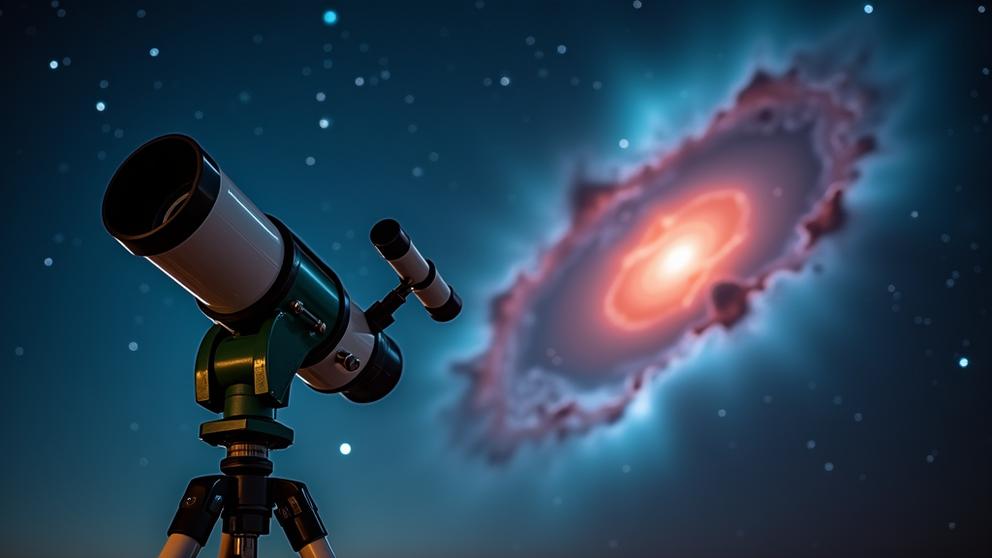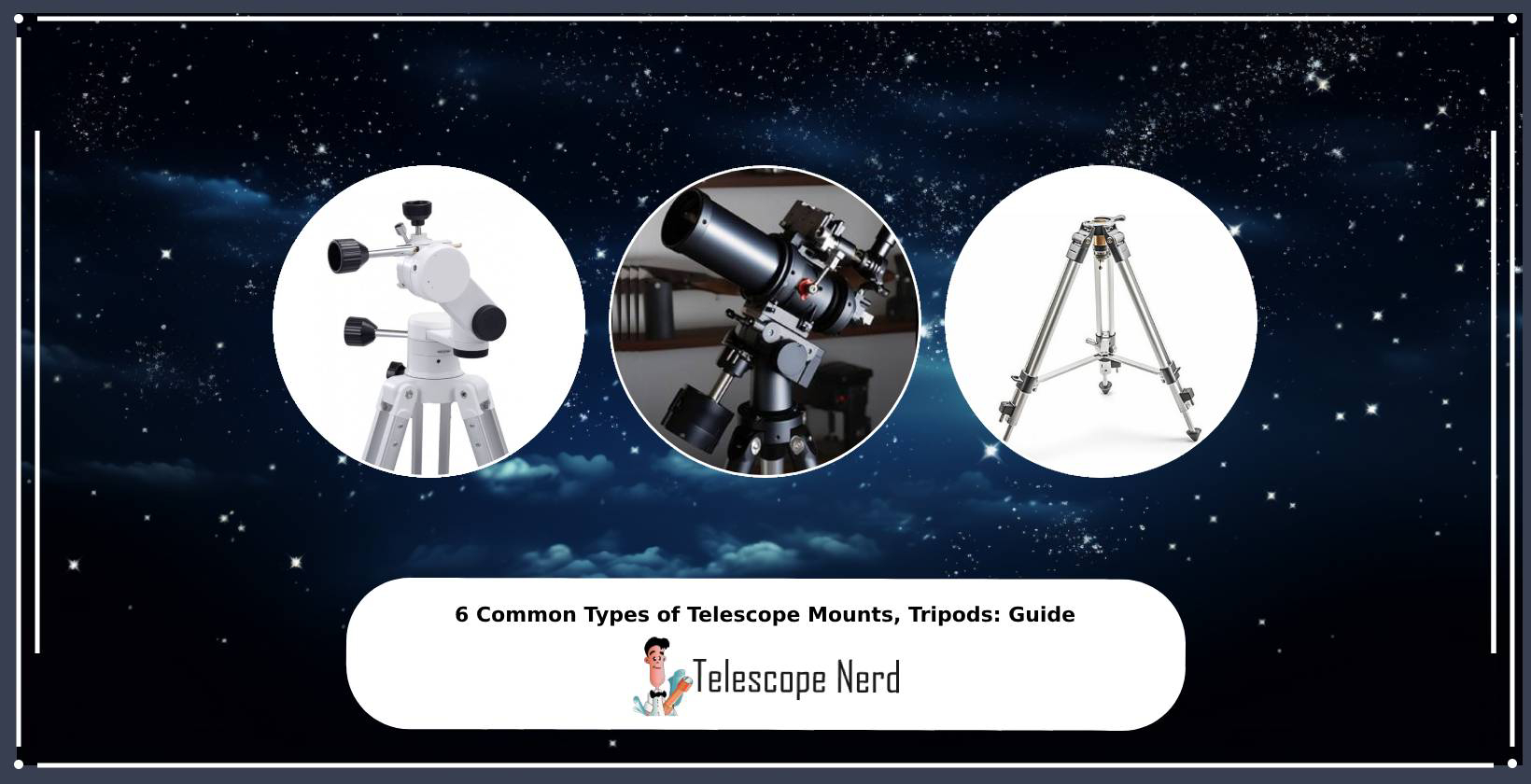Telescope Mount: Types, Where to Buy
Telescope mounts are mechanical structures that support and control telescopes. Mounts consist of a base, support system, and mounting head, enabling precise positioning and tracking of celestial objects. The base provides stability, the support system allows smooth motion, and the mounting head secures the telescope. Telescope mounts come in various types, each designed for specific observational needs. Altazimuth mounts move in altitude and azimuth axes, ideal for observing near-horizon objects. Equatorial mounts align with Earth’s rotational axis, facilitating deep-space object tracking. German equatorial mounts offer precise movement, popular among astrophotographers. Other mount types include Dobsonian, fork, computerized, and star tracker mounts. Advanced computerized mounts utilize electronic controls for automated tracking and pointing, enhancing astronomical research and imaging efficiency.
What is a telescope mount?
Telescope mounts are mechanical structures supporting telescopes. Mounts allow accurate pointing and tracking of celestial objects. Telescope mount mechanical structures consist of tripods or legs for stability. Rotating heads hold telescopes, enabling movement in two axes. Mounts support telescope mass ranging from kilograms to tons. Motors drive some mounts for precise movement.
The telescope mount structure consists of three main parts: a base, support system, and mounting head. The telescope mount base provides a stable foundation and minimizes vibrations, ensuring optimal image quality. The support system elevates the mount and enables smooth tracking motions. The telescope mount instrument attaches directly to the telescope, securing it in place.
Telescope mounts come in various types, including altazimuth and equatorial mounts. Altazimuth mounts move in altitude and azimuth axes, making them suitable for observing objects near the horizon. Equatorial mounts align with Earth’s rotational axis, allowing easier tracking of deep-space objects. German equatorial mounts offer precise movement and are popular among astrophotographers.
Telescope mounts serve crucial functions in astronomy. They enable precise positioning of telescopes towards specific celestial coordinates. Telescope mounts track objects across the sky as Earth rotates, compensating for the planet’s motion. Advanced computerized mounts use electronic controls for automated tracking and pointing, enhancing the efficiency of astronomical research and imaging.
What is the best telescope mount?
Telescope mounts are critical components for successful astrophotography and observation. The best telescope mount combines stability, tracking accuracy, and payload capacity to deliver optimal performance. Stability ensures sharp images and precise tracking. Tracking accuracy is essential for long-exposure astrophotography. Payload capacity determines the mount’s ability to support telescopes and accessories.
German Equatorial Mounts (GEMs) provide exceptional stability for astrophotography. GEMs handle heavy payloads and minimize vibrations during imaging sessions. High-quality GEMs track celestial objects within 1-2 arcseconds per minute. The Losmandy G11 mount offers a 75-pound payload capacity, accommodating a wide range of telescopes.
Computerized mounts with goto capabilities simplify object location and tracking. Modern GEMs feature built-in databases containing thousands of celestial objects. The Paramount MYT mount includes a computer system with a 40,000+ object database. Goto functionality allows users to quickly locate and center desired targets.
Portability is crucial for astrophotographers who travel to dark sky sites. Lightweight mounts like the iOptron CEM60 weigh only 27 pounds, balancing portability and stability. The Paramount MYT weighs 35 pounds, offering a good compromise between features and transportability.
Mount prices range from hundreds to thousands of dollars. Entry-level computerized GEMs like the Celestron CGX start around $2,000. High-end mounts such as the Astro-Physics 3600GTO can cost up to $10,000. The Paramount MYT, priced around $6,000, offers professional-grade features for serious astrophotographers.

What is the best telescope mount for astrophotography?
German Equatorial Mounts (GEMs) are the best telescope mounts for astrophotography. GEMs offer excellent stability and tracking capabilities, handling weights up to 100 lbs (45 kg) for astrophotography. High-end mounts like the Astro-Physics Mach2 provide exceptional performance for serious astrophotographers. The Astro-Physics Mach2 offers smooth, quiet operation and can handle weights up to 100 lbs (45 kg). Another top-tier option is the 10Micron GM1000HPS, designed for professional astrophotography with unparalleled stability and precision. The 10Micron GM1000HPS supports weights up to 220 lbs (100 kg) and features advanced tracking and guiding capabilities.
Mid-range mounts offer excellent performance for intermediate astrophotographers. The Sky-Watcher EQ6-R Mount is a popular choice, handling weights up to 44 lbs (20 kg) and featuring a built-in autoguider port. The iOptron CEM60 is another high-quality option in this category, providing excellent tracking and guiding capabilities.
Budget-friendly mounts cater to beginners and hobbyists. The Celestron Advanced VX can handle weights up to 30 lbs (14 kg) and includes a built-in autoguider port. The Sky-Watcher EQM35-Pro Mount supports weights up to 77 lbs (35 kg) and offers advanced tracking features. The Orion Sirius EQ-G is another reliable option in this price range.
Portable mounts are ideal for astrophotographers on the go. The iOptron SkyGuider Pro handles weights up to 11 lbs (5 kg) for small telescopes and cameras. The Sky-Watcher Star Adventurer supports weights up to 5 lbs (2.3 kg) and provides excellent tracking for wide-field astrophotography.

What are the different types of telescope mounts?
There are various types of telescope mounts available for different purposes. Here are ten different types of telescope mounts.
- Equatorial mount
- Tracking mount
- Dobsonian mount
- Goto mount
- Motorized mount
- Altazimuth mount
- Fork mount
- Computerized mount
- German equatorial mount
- Star tracker mount
1. Equatorial mount
An equatorial mount is a specialized telescope mount designed to track celestial objects as they move across the sky. Equatorial mounts align with Earth’s rotational axis, allowing precise tracking of stars and planets. The mount compensates for Earth’s rotation by moving in a single axis, simplifying long-exposure astrophotography and extended observations.
Equatorial mount systems consist of two primary axes: right ascension (RA) and declination (Dec). The RA axis parallels Earth’s rotational axis, while the Dec axis allows movement perpendicular to the RA axis. Equatorial mount tracking uses motorized drive systems to rotate at 15 degrees per hour, matching Earth’s rotation rate. These mounts require careful polar alignment with the celestial pole for optimal performance.
Equatorial mounts offer several advantages in astronomy. They provide smooth, accurate tracking of celestial objects, essential for deep-sky observing and planetary studies. Equatorial mount systems simplify astrophotography by keeping objects centered in the field of view during long exposures. Astronomers use equatorial coordinates with these mounts to easily locate and track specific objects in the night sky.
Two common types of equatorial mounts are the German Equatorial Mount (GEM) and the fork mount. GEMs feature a counterweight system to balance the telescope, while fork mounts offer a more compact design. Equatorial mount setup involves precise polar alignment and careful balancing of the telescope. Astronomers adjust altitude and azimuth controls to align the mount with the celestial pole, ensuring accurate tracking throughout observations.
2. Tracking mount
A tracking mount is a motorized telescope mount that automatically follows celestial objects as they move across the sky. Tracking mounts compensate for Earth’s rotation, allowing astronomers to observe or photograph objects for extended periods without manual adjustments.
The tracking mount system consists of several key components. Motorized axes, right ascension and declination, provide precise movement control. A computerized control system manages the mount’s operation and tracking algorithms. A power source, either a battery or AC adapter, supplies electricity to the system.
Tracking mount trackers employ sophisticated technology to maintain accurate object tracking. The star alignment process calibrates the mount’s position relative to known celestial objects. An extensive object database stores coordinates and information for thousands of celestial targets. Precision tracking algorithms calculate object positions and adjust the mount’s movement to maintain accurate tracking.
Tracking mount systems achieve high levels of accuracy in following celestial objects. High-quality mounts maintain tracking errors as low as 1-2 arcseconds per hour. This precision allows for long-exposure astrophotography with exposure times up to several hours. Accurate tracking enables astronomers to conduct detailed spectroscopic observations and gather valuable data on celestial object composition and properties.
3. Dobsonian mount
A Dobsonian mount is a simple and inexpensive altazimuth mount for Newtonian reflector telescopes. John Dobson popularized the Dobsonian mount in the 1960s. Dobsonian mounts were designed to make large aperture telescopes more accessible to amateur astronomers.
The Dobsonian mount reflector features a large aperture Newtonian telescope. These telescopes are optimized for visual observation of deep sky objects. Apertures of Dobsonian reflectors commonly range from 6 to 16 inches or larger.
The Dobsonian mount base consists of a sturdy wooden or metal platform. The base allows smooth 360-degree rotation in azimuth. A rocker box sits on top of the base, enabling altitude adjustment of the telescope tube. Teflon pads or roller bearings are used to facilitate smooth motion in both axes.
Dobsonian mount portable design makes it popular among amateur astronomers. The mount breaks down into manageable components for easy transport. Setup and takedown can be completed in under 5 minutes by experienced users. A typical 8-inch Dobsonian weighs around 40 pounds when fully assembled.
4. Goto mount
A Goto mount is a computerized telescope mount that automatically locates and tracks celestial objects in the night sky. Goto mounts combine mechanical and electronic components to simplify the process of finding and observing astronomical targets. These sophisticated instruments are available in both equatorial and altazimuth designs, catering to different telescope sizes and weights.
Goto mount assembly involves attaching the mount head to the tripod and installing the telescope. Additional steps may include attaching counterweights for balance. Goto mount tripod provides a stable platform for the mount and telescope, featuring adjustable legs and a leveling system. Goto mount setup requires entering date, time, and location information, followed by initializing the computerized system.
Goto mount alignment is critical for accurate functionality. Astronomers align Goto mounts with celestial poles using a polar alignment procedure. Star alignment and calibration ensure precise pointing and tracking. Goto mount control utilizes a database of celestial objects to guide the mount. Users access the control system through a hand controller or mobile app, inputting object coordinates or selecting from the database.
Goto mount accuracy depends on mount quality, alignment precision, and control system accuracy. High-end Goto mounts achieve accuracy of ±1-2 arcminutes, while more affordable models offer accuracy of ±5-10 arcminutes. Regular calibration and maintenance contribute to optimal performance. Goto mounts use motors and gears to slew the telescope to desired objects, automatically moving it to the correct position for observation.
5. Motorized mount
Motorized mounts use electric motors to automatically track celestial objects as they move across the sky. GoTo mounts and Push-To mounts are two main types of motorized mounts. GoTo mounts have fully automated pointing and tracking capabilities. Push-To mounts provide electronic assistance for manual pointing.
Motorized mounts feature computerized object databases containing thousands of celestial targets. Advanced alignment systems allow quick and accurate polar or star alignment. Automatic tracking keeps objects centered in the eyepiece or camera field of view for extended periods.
A motorized mount system consists of precision motors, gearing mechanisms, and control electronics. Motors drive the mount’s axes to provide smooth and accurate motion. Gears reduce motor speed and increase torque for precise movement. Control electronics coordinate the motors and interface with the user.
Hand controllers, smartphone apps, and computer software provide multiple options for controlling motorized mounts. Hand controllers offer push-button operation and menu-driven interfaces. Mobile apps allow wireless control via Bluetooth or WiFi connections. Planetarium software enables mount control through a computer.
Motorized mounts move in right ascension and declination to track objects across the celestial sphere. Slewing speeds reach up to 5 degrees per second for rapid pointing. Tracking rates match sidereal, lunar, or solar motion for different observing situations.
Power supplies, GPS modules, and autoguiders are common accessories for motorized mounts. External power supplies or battery packs provide extended operating time. GPS modules automate location and time input. Autoguiders improve tracking accuracy for long-exposure astrophotography.
6. Altazimuth mount
An altazimuth mount is a simple two-axis mount for telescopes and other astronomical instruments. The altazimuth mount type consists of a base, a tripod, and a moving head. Altazimuth mounts allow movement in two perpendicular axes: altitude and azimuth. Altitude movement ranges from -90° to +90° for tracking objects at different elevations. Azimuth movement ranges from 0° to 360° for tracking objects across the sky.
The altazimuth mount base provides a stable foundation for the mount. Altazimuth mount tripods are adjustable from 0.5 to 1.5 meters (1.6 to 4.9 feet). A base plate attaches the altazimuth mount to the tripod for easy leveling and adjustment. Altazimuth mounts have a load capacity of 10-20 kg (22-44 lbs).
Altazimuth mount movements are manual, with users adjusting knobs to track objects. Modern altazimuth mounts feature motorized or computerized movement for precise tracking. Some altazimuth mounts include slow-motion controls for fine position adjustments. Altazimuth mount movement allows smooth and precise positioning for visual observing and astrophotography.
7. Fork mount
A fork mount is a type of telescope mount consisting of a U-shaped fork that holds the optical tube. Fork mounts are popular among amateur astronomers for their stability and ease of use. The main components of a fork mount include the fork arms, drive base, and optical tube assembly.
The fork mount bracket cradles the telescope in a U-shape or Y-shape. Fork mount parts include the bracket, base, and counterweight. The fork mount base provides a stable platform for the assembly and supports the bracket, allowing rotation for tracking celestial objects. Fork mount weight capacity varies by model, ranging from 10-50 pounds or more.
Fork mount mounting options include tripods and piers. The fork mount tripod provides a stable platform for the entire assembly, allowing smooth and vibration-free tracking of objects. Fork mounts are used in equatorial configurations for precise celestial tracking.
Fork mount construction features sturdy cast-metal or machined-aluminum materials. The construction includes a smooth rotating surface for accurate tracking. The fork mount’s mounting surface features specific dovetail patterns to accommodate different types of telescopes.
8. Computerized mount
Computerized mounts are automated telescope mounts that use motors and computer control for precise positioning and tracking. Computerized mount systems consist of integrated motors, gears, electronic control units, and software for object location and tracking. These systems offer high accuracy, achieving ±1-5 arcsecond tracking accuracy and ±1-10 arcminute location accuracy.
Computerized mount controllers serve as the brain of the system. Controllers feature handheld or built-in control pads, extensive databases of 10,000-100,000 celestial objects, and user-friendly interfaces for mount operation. Users input desired objects into the controller, which calculates object positions and sends movement commands to the mount motors.
Computerized mount equatorials combine computerized control with equatorial alignment. Equatorial computerized mounts are preferred for astrophotography, excelling at long exposures and precise object tracking using polar-aligned axes. These mounts utilize equatorial coordinate systems for accurate celestial navigation.
Computerized mount motors provide smooth and precise movement. Motors drive mount movements accurately, moving at 1-10°/second. Computerized mount motors enable automatic tracking and slewing, utilizing precision gearing and encoders for optimal performance.
Computerized mount compatibility extends to various telescope types. Many computerized mounts are compatible with astronomy software and apps, enhancing their functionality. Popular computerized mount systems include Celestron NexStar and Meade LX200, offering ease of use to amateur astronomers and precision to astrophotographers.
9. German equatorial mount
German equatorial mounts are popular telescope mounting systems used by amateur astronomers. These mounts feature a T-shaped design with one axis aligned parallel to Earth’s rotation axis. German equatorial mounts compensate for Earth’s rotation by tracking celestial objects along their apparent motion in the night sky.
German equatorial mount alignment is crucial for accurate tracking. The polar axis must be pointed towards the celestial pole, tilted at an angle equal to the observer’s latitude. Declination axis is perpendicular to the polar axis. Proper alignment allows smooth rotation around both axes to keep objects centered in the telescope’s field of view.
German equatorial mount south configuration requires specific adjustments. Counterweights are positioned opposite to the telescope tube for balance. Telescope orientation is reversed compared to Northern Hemisphere setups. Southern Hemisphere users align the mount with the South Celestial Pole near the star Sigma Octantis.
German equatorial mount tracking is achieved through precise motor-driven mechanisms. Single-axis motor drives rotate the mount at 15° per hour to counteract Earth’s rotation. Tracking accuracy ranges from ±10 to 30 arcseconds. German equatorial mounts are ideal for long-exposure astrophotography, maintaining object positions for extended periods.
German equatorial mounts are versatile and accommodate various telescope types and weights. Weight capacities range from 10 to 50 kg. Power consumption for tracking motors is 1 to 5 W. German equatorial mounts are compact, portable, and more affordable than other equatorial mount types.
10. Star tracker mount
Star tracker mounts are specialized equatorial mounts designed for astrophotography. These mounts compensate for Earth’s rotation by precisely tracking celestial objects across the night sky. Star trackers allow for long-exposure photography without star trailing, enabling the capture of faint deep-sky objects.
Key features of star tracker mounts include precise tracking accuracy and motorized drive systems. High-quality star trackers achieve tracking accuracy of ±1-5 arcseconds per minute. Modern star trackers incorporate autoguiding capabilities for even higher accuracy. Star tracker mounts are used with DSLR cameras or small telescopes, offering a lightweight and portable solution for astrophotographers.
Star tracker mounts operate by aligning their rotational axis with Earth’s polar axis. The mount is programmed to rotate at the sidereal rate of 360 degrees per 23 hours, 56 minutes, and 4.09 seconds. This rotation matches Earth’s rotation, keeping the telescope or camera fixed on the target object throughout the observation period.
Astrophotographers benefit greatly from star tracker mounts. These mounts significantly reduce star trailing in long-exposure images. Star trackers enable the capture of detailed images of galaxies, nebulae, and other faint deep-sky objects. The improved tracking accuracy results in sharper images with enhanced detail and clarity.
Is it safe to buy used telescope mounts?
Secondhand telescope mounts require careful consideration. Mount purchases demand thorough research, inspection, and reputable sellers. Buyers must assess condition, verify functionality, and check compatibility. Used mounts offer cost-effective options but lack warranties. Potential risks include wear, outdated technology, and hidden damage. Safety precautions involve testing before purchase and examining maintenance history.
Functionality testing is essential before purchasing a used mount. Smooth movement should be verified by manually rotating all axes. Weight capacity must be tested to ensure the mount can support the intended telescope. Seller reputation plays a significant role in safe purchases. Buyers should review seller feedback and ask for detailed photos and information about the mount’s history.

Price comparison helps ensure a fair deal on used telescope mounts. Used mounts cost between 20% to 50% of the original retail price, depending on condition and age. Hidden defects pose a potential risk when buying used mounts. Buyers should request a return policy and consider professional inspection for high-end mounts over $1,000.
Compatibility issues can arise with used telescope mounts. Mount type and specifications must be verified to match the intended telescope. Telescope mounts are precision instruments whose condition directly impacts performance. Well-maintained mounts from reputable manufacturers like Celestron, Meade, or Losmandy can last 10-20 years with light usage.
Where to buy used telescope mounts?
Cloudy Nights Classifieds is a popular forum for finding used telescope mounts. Astronomy enthusiasts list their equipment for sale, offering a wide variety of options.
Astromart.com specializes in used astronomy equipment including telescope mounts. The website features a dedicated section for mounts from various manufacturers and price ranges.
Craigslist offers local listings for used telescope mounts. Buyers should exercise caution and meet sellers in public places when making purchases through this platform.
Facebook Marketplace allows users to search for used telescope mounts near their location. The platform’s messaging system facilitates communication between buyers and sellers.
Local Goodwill stores occasionally have used telescope mounts available at low prices. Regular visits to these stores increase the chances of finding quality equipment at bargain prices.
eBay provides a large selection of used telescope mounts for sale from many sellers. The platform’s buyer protection policies offer some security for purchases.
High Point Scientific carries pre-owned telescope mounts inspected by knowledgeable staff. Their inventory includes mounts from reputable brands with detailed condition descriptions.
OPT (Oceanside Photo & Telescope) sells used telescope mounts from top manufacturers. Their experienced staff provides expert advice on selecting the right mount for specific needs.
Thousand Oaks Optical offers used telescope mounts with expert advice from staff. Their inventory includes both entry-level and advanced mounts for various telescope types.
Orion Telescopes & Binoculars provides certified pre-owned telescope mounts that meet quality standards. Each mount undergoes thorough inspection and testing before being listed for sale.
Sky-Watcher USA features used telescope mounts on their website, with warranties. Their pre-owned equipment offers a cost-effective way to acquire high-quality mounts.
Cloud Break Optics sells used telescope mounts at competitive prices. Their selection includes mounts suitable for both visual observation and astrophotography.
Player One Astronomy offers used telescope mounts with guidance from staff. Their team assists buyers in choosing mounts compatible with existing equipment.
What is a telescope tripod?
Telescope tripods provide stable bases for telescope mounts. Telescope mounts support telescope mass and enable precise movement. Tripods are three-legged stands made of aluminum, steel, or carbon fiber. Tripods offer strength, durability, and portability. Tripods stabilize telescopes for smooth movement and accurate celestial object tracking. Tripods support 10-50 kg and adjust from 0.5-1.5 meters in height.
Telescope tripods enable precise positioning and movement of telescopes. Tripods allow pointing of telescopes at celestial objects with accuracy. Smooth tripod movement aids in tracking celestial bodies as they move across the night sky. Tripods enhance overall telescope performance in multiple ways. Sturdy tripods improve the observing experience by maintaining a steady view. Tripods affect magnification capabilities by providing a stable platform for high-power observations. Tripods enable steady imaging for astrophotography, allowing for longer exposure times.
Many telescopes come with tripods included in the package. Separate tripod purchases may be necessary for some telescopes to match specific needs. Tripods offer flexibility for different observing setups and locations. Telescope tripod parts include legs, mounts, and heads for attaching the telescope. Telescope tripods are available in various designs, including equatorial, altazimuth, and computerized models.

